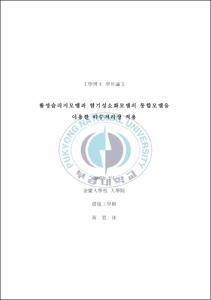활성슬러지모델과 혐기성소화모델의 통합모델을 이용한 하수처리장 적용
- Alternative Title
- Application of Combined Model of Activated Sludge Model and Anaerobic Digestion Model to Wastewater Treatment Plan
- Abstract
- For a design of wastewater treatment plant, it is required to estimate the change of water quality for 20 years or so hereafter. Also, when the problems were found in treatment plants, we must quickly search for causes and efficient resolutions, and need practical tools for a management of plant and operator's training. It is a way to find suitable models for settling these necessities.
Effluent standard of nitrogen and phosphorus concentration is expected to be reinforced by 20, 2mg/L from 2008. However, most wastewater treatment plants are now in operation by standard activated sludge method without consideration of nutrient, and due to low efficiency of elimination rate of nitrogen, it is true that it needs to establish an additional process for a nitrogen removal.
In the case of new construction of sewage treatment plant, the process of BNR is expected to be established, but more than 75% of the existing wastewater treatment plant are now in operation by standard activated sludge method, and since it takes too much time and financial resources to change existing processes into BNR processing methods, it is recommended to examine the structure of existing wastewater treatment works, and heighten the efficiency of removal rate of nitrogen and phosphorus. It is of importance to search for the most suitable operating conditions through estimation for existing wastewater treatment plant and before change attempt for operating, it is essential to design a modelling for process.
However, existing modelling of wastewater treatment plant mainly has constituted sewerage treatment process modelling. Under these modelling, there were a great gap between the results of modelling and real operation due to considering the same amount of side stream flow that is exhausted anaerobic digestion processing of wastewater sludge and dehydration process etc. Therefore, for easy-application of the field, it is desirable to develop optimal model which added anaerobic digestion model in the basis of design of wastewater process and operating data.
Besides, it is estimated that it may reduce time and expense through forecasting various results by using modelling rather than using know-how or various kinds experiment results obtained from the persons who experienced in wastewater treatment plants for estimation of wastewater treatment plant and operating condition change.
This research decides connecting factor for combined model of wastewater treatment plant which associated with examined activated sludge model and anaerobic digestion sludge model and presumes sensitivity analysis and parameter estimation and calibration as well as compares with real operation and then forecasts layout of whole sewage treatment plant and operating management involved activated sludge process and anaerobic digestion sludge process. The following is the conclusion of combined model of sewage treatment plant that mixes activated sludge model with anaerobic digestion sludge model.
To combinate activated sludge model with anaerobic digestion sludge model, we converted state variable of activated sludge model to variable of anaerobic digestion sludge model and in reserve anaerobic digestion sludge model to state variable of activated sludge model , and simulated and confirmed that there was consistence between COD and TKN's material balance before and after conversion.
The result of sensitivity analysis of combined model of wastewater treatment plant of mixed activated sludge model and anaerobic digestion sludge model showed the order of pK_(a_h2o), k_(A/B_co2), Y_(H), b_(A), b_(H).
As a result of examining wastewater treatment plant operation data in 2006 after estimating the parameter of wastewater treatment plant operation data in 2005, we found that similar tendency in operating results of wastewater treatment plant was shown in both data and could apply to forecasting layout of the whole wastewater treatment plants included activated sludge process as well as digestion sludge process.
Use of combined model of activated sludge model and anaerobic digestion sludge model alters the operation of existing treatment plants with ease, and through simulation of MLE process focusing on removal of nitrogen out of nutrient, it can be possible to calculate the quality of disposal flow water of each process and the variations of gas production, and indeed it is considered to be utilized in the case of constructing additional plants or changing of operation method of existing wastewater treatment plants.
This study is the first attempt that applies the combined model with activated sludge model and anaerobic digestion model to wastewater treatment plant in Korea.
- Issued Date
- 2007
- Awarded Date
- 2007. 2
- Type
- Dissertation
- Keyword
- Activated Sludge Model Anaerobic Digestion Model Combined Model Nutrient Removal Wastewater Treatment Plant
- Publisher
- 부경대학교 대학원
- Alternative Author(s)
- Hwang, Eun-Ju
- Affiliation
- 부경대학교 대학원
- Department
- 대학원 환경공학과
- Advisor
- 이병헌
- Table Of Contents
- 제 1 장 서론 = 1
1.1 연구 배경 = 1
1.2 연구 내용 = 2
제 2 장 이론적 배경 = 3
2.1 활성슬러지 모델 = 3
2.2 소화조 모델 = 12
2.3 ASM모델과 ADM모델 및 ADM모델과 ASM모델의 상태변수전환 = 33
2.4 질소 제거 = 53
2.5 고도하수처리 공정 = 57
제 3 장 연구방법 = 61
3.1 하수처리장 자료 = 61
3.2 유입수 성상 분류 = 66
3.3 민감도분석 및 매개변수 추정, 검정 = 70
제 4 장 모델링 결과 및 고찰 = 71
4.1 ASM1 - ADM1 통합모델을 위한 물질수지 = 71
4.2 민감도 분석결과 = 76
4.3 매개변수 추정결과 = 80
4.4 모델 결과 비교분석 = 82
4.5 통합모델의 검정 = 91
4.6 MLE 공정 적용 결과 = 96
제 6 장 결론 = 100
감사의 글 = 101
참고문헌 = 103
기호표 = 113
- Degree
- Doctor
- Files in This Item:
-
-
Download
 활성슬러지모델과 혐기성소화모델의 통합모델을 이용한 하수처리장 적용.pdf
기타 데이터 / 2.57 MB / Adobe PDF
활성슬러지모델과 혐기성소화모델의 통합모델을 이용한 하수처리장 적용.pdf
기타 데이터 / 2.57 MB / Adobe PDF
-
Items in Repository are protected by copyright, with all rights reserved, unless otherwise indicated.